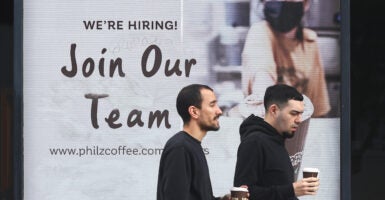A smaller percentage of Americans are working today than did four years ago.
The Bureau of Labor Statistics reported that payroll employment edged up by 114,000 in July as the unemployment rate rose to 4.3%. Aside from the pandemic, the last time the unemployment rate was 4.3% or higher was almost seven years ago, in Oct. 2017.
But the unemployment rate alone understates rising non-employment in the United States.
Over the past year, the population of people ages 16 and older increased by 1.8 million, but the number of those who are employed rose by only 57,000. That means only one out of every 32 was a net increase in employment.
Whereas the unemployment rate tells us the percent of people who want jobs but do not have them, the employment-to-population ratio tells us what percent of people are working.
Over the past year, the employment-to-population ratio of the people ages 16 and older fell from 60.4 to 60.0. That’s equivalent to 934,000 fewer people working today than just a year ago. And compared to 2020, just prior to the pandemic, there are 2.9 million fewer people working.
Part of that decline is the result of baby boomers retiring—including some retiring earlier-than-planned due to a windfall increase in wealth caused by the steep rise in home prices since 2020.
If another part of the decline were a shift from formal paid employment to more non-paid work caring for children and aging parents or volunteering, that would make the steep decline in employment less concerning. But the employment-to-population ratio of prime-age workers—ages 25 to 54—has actually increased slightly since the beginning of 2020, as has that of workers with children.
The particularly troubling decline has been a 2.4 percentage point drop in the employment-to-population ratio of young Americans, ages 20 to 24, from 68.2 in Feb. 2020 to 65.4 today. This loss of 500,000 workers ages 20 to 24 is even more problematic when factoring in a 1.3 million decline in college enrollment since 2019.
Idleness during the prime years of gaining education and experience can have lifelong consequences. Economic studies show that long periods of unemployment have lasting negative impacts on workers’ opportunities and earnings, their physical work capabilities and stress levels, and even their fertility. Long periods of unemployment and idleness also increase the likelihood of spending a lifetime on Disability Insurance instead of working.
Work is essential to a well-functioning society, and it is fundamental to human wellbeing. In contrast, the absence of work among capable individuals is a drain on the economy, a burden on the federal budget and other Americans’ incomes, and a loss of human potential.
Policymakers can simultaneously relieve economic and fiscal constraints and add to human flourishing by creating an environment in which more Americans want to work and are able to find fulfilling work. That should start with: expanding apprenticeships and alternative education, replacing failed federal job training programs with more effective private and state and local programs, allowing states to adapt better welfare and workforce models like Utah’s “One Door” policy, eliminating unnecessary regulations that reduce jobs and wage gains, and protecting flexible work opportunities and successful small business models.
The good news for policymakers is that none of these actions requires more spending or new programs.
Following the principle of the ancient Greek physician Hippocrates, “first, do no harm,” policymakers should address declining employment by remove government-imposed barriers to work.





























